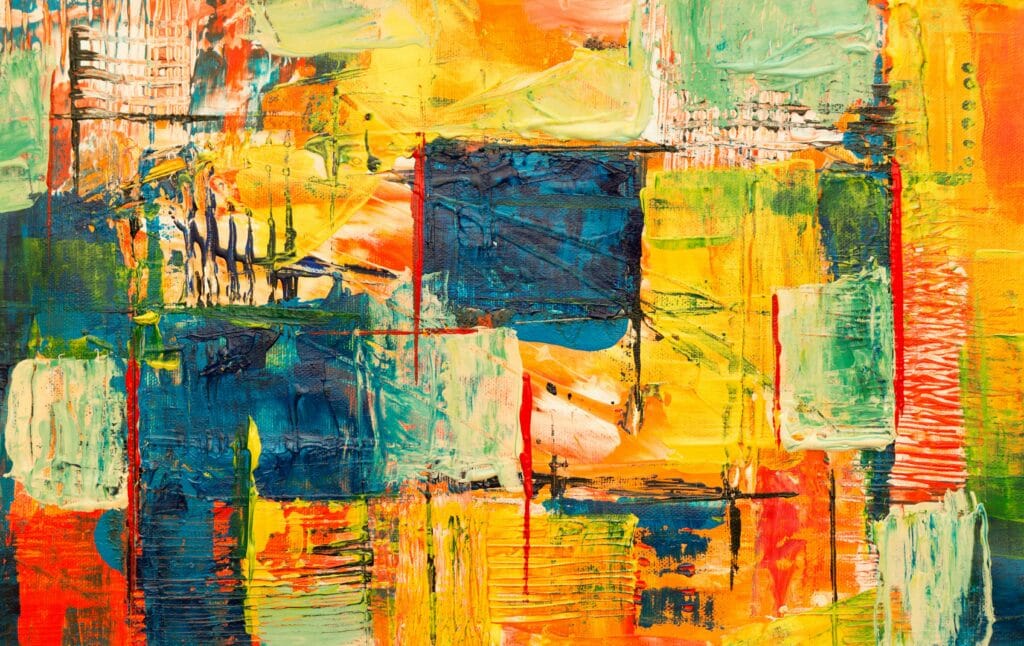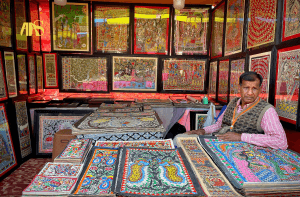Modern contemporary paintings stand as a testament to our ever-changing society and culture. These vibrant, thought-provoking works capture the essence of our time, challenging traditional notions of art and inviting viewers to explore new perspectives.
Whether you’re an art enthusiast, a curious student, or simply someone looking to deepen your understanding of today’s artistic landscape, this comprehensive guide will take you on a journey through the captivating realm of modern contemporary paintings.
From its rich history and influential artists to the latest trends shaping the art market, we’ll explore every facet of this exciting genre.

What will you learn!
Examples of contemporary paintings, including some of the exquisite Canvas Paintings available at artacestudio.com. These carefully curated pieces not only illustrate the concepts we’ll discuss but also offer inspiration for your own art collection or creative endeavors.
What are Modern Contemporary Paintings?
Modern contemporary paintings represent the cutting edge of artistic expression in our time, encompassing works created from the late 20th century to the present day.
Unlike their historical counterparts, these paintings reflect the rapidly changing world around us, often challenging traditional notions of art and pushing boundaries in both technique and concept.
To truly understand modern contemporary paintings, it’s crucial to distinguish them from modern art. While modern art typically refers to works created from the 1860s to the 1970s, contemporary art picks up where modernism left off.
This distinction is important for art enthusiasts and collectors alike, as it helps contextualize the works within the broader art historical narrative.
Key characteristics of modern contemporary paintings include:
- Diversity of styles and techniques
- Incorporation of new technologies and materials
- Emphasis on conceptual and socially engaged art
- Blurring of boundaries between different art forms
- Global perspectives and cultural fusion
The evolution of contemporary painting
The journey of contemporary painting is deeply rooted in the historical context of the late 20th century.
As the world experienced rapid technological advancements, globalization, and social changes, artists began to explore new ways of expressing these shifts through their work.
Major movements that have shaped contemporary painting include:
- Neo-Expressionism: A revival of emotive, figurative painting in the 1980s
- Postmodernism: Challenging grand narratives and embracing plurality
- Digital Art: Incorporating computer-generated imagery and new media
- Street Art: Bringing art from galleries to public spaces
These movements have had a profound impact on how we perceive and create art today.
For instance, the rise of digital art has opened up new possibilities for canvas paintings, allowing artists to blend traditional techniques with digital enhancements.
To better understand this evolution, imagine a timeline of contemporary art development:
- 1970s: Conceptual art gains prominence
- 1980s: Neo-Expressionism and the return to painting
- 1990s: Young British Artists (YBAs) shake up the art world
- 2000s: Rise of digital and new media art
- 2010s: Socially engaged art and global perspectives
- 2020s: AI-assisted art and virtual reality experiences
This timeline illustrates how contemporary painting continues to adapt and respond to our changing world, making it an exciting field for both creators and admirers of art.
Characteristics and Techniques of Modern Contemporary Paintings
Modern contemporary paintings are characterized by their innovative approaches, diverse themes, and unique relationship between artist and audience.
Experimental approaches and mediums
Contemporary artists are constantly pushing the boundaries of traditional painting techniques, embracing experimentation and unconventional materials. This innovative spirit has led to the emergence of several key trends:
Mixed media and unconventional materials:
Artists are no longer confined to paint and canvas. Many contemporary painters incorporate a wide range of materials into their work, including:
- Found objects
- Textiles
- Industrial materials
- Organic substances
For example, artist Anselm Kiefer is known for his use of lead, straw, and ash in his large-scale paintings, creating textured works that blur the line between painting and sculpture.
Digital and technological integration:
The digital age has had a profound impact on modern contemporary paintings.
Artists are now:
- Using digital tools to create or enhance their work
- Incorporating elements of digital culture into traditional paintings
- Exploring the intersection of physical and digital art forms
David Hockney’s iPad drawings, later printed on canvas, exemplify this fusion of traditional and digital techniques.
Performance and installation art:
Contemporary painting often extends beyond the canvas, incorporating elements of:
- Performance art
- Interactive installations
- Site-specific works
These approaches challenge our perception of what constitutes a “painting” and invite viewers to engage with art in new ways.
Themes and subjects explored
Modern contemporary paintings often tackle complex and relevant themes, reflecting the concerns and experiences of our time:
Social and political commentary:
Many artists use their work to comment on current events, social issues, and political landscapes. For instance, Kehinde Wiley’s portraits challenge traditional representations of power and identity in art history.
Identity and cultural exploration:
Contemporary paintings frequently delve into questions of personal and cultural identity, exploring themes such as:
- Gender and sexuality
- Race and ethnicity
- Cultural heritage and diaspora
Yinka Shonibare’s works, which often incorporate African textiles, examine the complexities of postcolonial identity and cultural hybridity.
Environmental concerns and sustainability:
As global awareness of environmental issues grows, many contemporary painters are addressing themes of:
- Climate change
- Biodiversity loss
- Sustainable practices in art-making
Artists like Olafur Eliasson create works that not only depict environmental concerns but also use eco-friendly materials and processes.
The role of the artist and audience
Modern contemporary paintings have redefined the relationship between artist, artwork, and audience:
Collaborative and participatory art:
Many contemporary artists invite audience participation, blurring the lines between creator and viewer.
This approach can involve:
- Interactive installations
- Community-based projects
- Co-created artworks
For example, Rirkrit Tiravanija’s relational aesthetics pieces often involve cooking and sharing meals with gallery visitors, challenging traditional notions of what constitutes a painting or art experience.
Conceptual art and the importance of ideas:
In contemporary painting, the concept behind the work is often as important as its visual execution. Artists like Jenny Holzer use text-based paintings to explore language, power, and communication.
Breaking the fourth wall in painting:
Contemporary artists frequently acknowledge the viewer’s presence and challenge the traditional separation between art and audience.
This can involve:
- Direct addresses to the viewer in the artwork
- Self-referential elements that draw attention to the painting as an object
- Works that extend beyond the canvas into the viewer’s space
By understanding these characteristics and techniques, art enthusiasts can better appreciate the depth and complexity of modern contemporary paintings.
Whether you’re looking to start your own collection or simply expand your knowledge, exploring these innovative approaches will enrich your art experience.
Influential Contemporary Painters and Their Works
Modern contemporary paintings have been shaped by a diverse group of artists who have pushed boundaries and redefined artistic expression.
Let’s explore some of the most influential figures in this dynamic field.
Pioneers of contemporary painting
Several groundbreaking artists have left an indelible mark on the world of modern contemporary paintings:
- Gerhard Richter: Known for his diverse range of styles, from photorealistic to abstract, Richter’s work challenges the very nature of painting. His “Abstraktes Bild” series exemplifies his ability to create depth and texture through layered applications of paint.
- Cindy Sherman: While primarily known for her photography, Sherman’s influence on contemporary painting is undeniable. Her self-portrait series has inspired countless painters to explore themes of identity and representation.
- Banksy: This anonymous street artist has revolutionized the art world with his politically charged stencil work. Banksy’s transition from street to canvas has blurred the lines between high and low art.
Emerging voices in contemporary painting
The landscape of modern contemporary paintings continues to evolve with new talents emerging globally:
- Njideka Akunyili Crosby: This Nigerian-born artist combines painting, drawing, and collage to create complex works that explore cultural identity and globalization.
- Jadé Fadojutimi: A rising star in the UK art scene, Fadojutimi’s vibrant, abstract paintings delve into personal experiences and emotions.
Case studies: Iconic modern contemporary paintings
Let’s analyze three significant works that have made a lasting impact:
- “The Physical Impossibility of Death in the Mind of Someone Living” by Damien Hirst (1991): While not a traditional painting, this iconic piece challenged perceptions of what constitutes art. It sparked debates about conceptual art and its place in the contemporary art world.
- “Untitled (Skull)” by Jean-Michel Basquiat (1981): This neo-expressionist work combines graffiti-like elements with raw, emotive brushstrokes. It exemplifies Basquiat’s exploration of identity, race, and class in America.
- “A Bigger Splash” by David Hockney (1967): Although created at the cusp of the contemporary era, this painting’s influence continues to resonate. Its bold colors and clean lines have inspired generations of painters to explore new ways of depicting everyday scenes.
These works have not only impacted the art world but have also influenced broader societal conversations about identity, consumerism, and the nature of art itself.
For a visual journey through these influential works, explore our Family paintings.
Appreciating and Interpreting Modern Contemporary Paintings
When viewing modern contemporary paintings, consider the following elements:
- Composition and use of space
- Color palette and its emotional impact
- Texture and brushwork
- Symbolism and hidden meanings
Ask yourself:
- What is my initial reaction to this piece?
- How does the artist use technique to convey their message?
- What might this work say about our current society or culture?
Contextualizing contemporary art
Understanding the context of a painting enhances your appreciation:
- Research the artist’s background and influences
- Consider the historical and cultural context of the work
- Explore the artwork’s relationship to contemporary issues
The Market for Modern Contemporary Paintings
Recent data shows a growing interest in modern contemporary paintings:
- Online art sales increased by 25% in 2020
- Emerging artists from diverse backgrounds are gaining recognition
- Sustainability and social responsibility are becoming key factors in art valuation
Collecting contemporary paintings
Tips for new collectors:
- Start by visiting galleries and art fairs to develop your taste
- Set a budget and stick to it
- Consider purchasing works by emerging artists
- Always buy what you love, not just for investment potential
Investing in contemporary art
While art can be a rewarding investment, it comes with risks:
- The art market can be volatile and unpredictable
- Authenticity and provenance are crucial factors
- Long-term appreciation is possible but not guaranteed
“The contemporary art market is increasingly global and diverse. Collectors should focus on acquiring works that resonate with them personally while also considering the artist’s potential for long-term recognition.” – Art Market Analyst
Future Trends in Contemporary Painting
Experts predict several exciting developments in modern contemporary paintings:
- Increased integration of augmented reality (AR) and virtual reality (VR) in painting
- Growing interest in bio-art and works that incorporate living organisms
- Revival of figurative painting with a contemporary twist
B. Globalization and diversity in contemporary painting
The art world is becoming increasingly interconnected:
- Rise of online platforms showcasing artists from underrepresented regions
- Increased cultural exchange leading to new hybrid art forms
- Growing recognition of indigenous art practices in contemporary contexts
Sustainability and eco-conscious art
Environmental concerns are influencing modern contemporary paintings:
- Use of eco-friendly, sustainable materials in art creation
- Artworks addressing climate change and conservation issues
- Integration of upcycled materials in paintings
Conclusion
Modern contemporary paintings offer a vibrant, ever-evolving landscape of artistic expression. From pioneering artists who have shaped the field to emerging voices bringing fresh perspectives, this art form continues to challenge, inspire, and reflect our changing world.
By understanding the characteristics, techniques, and market dynamics of contemporary painting, you’re now better equipped to appreciate and engage with this exciting art form.
Whether you’re an aspiring collector, a curious art lover, or simply someone looking to broaden your cultural horizons, the world of modern contemporary paintings has something to offer you.
We encourage you to explore contemporary art in person at local galleries and museums. Continue learning about new artists and movements, and don’t be afraid to form your own opinions. Remember, in the world of contemporary art, your perspective is just as valuable as anyone else’s.
Ready to dive deeper into the world of modern contemporary paintings? Check out our curated collection of artworks and start your journey today!





